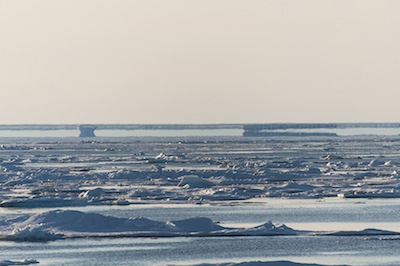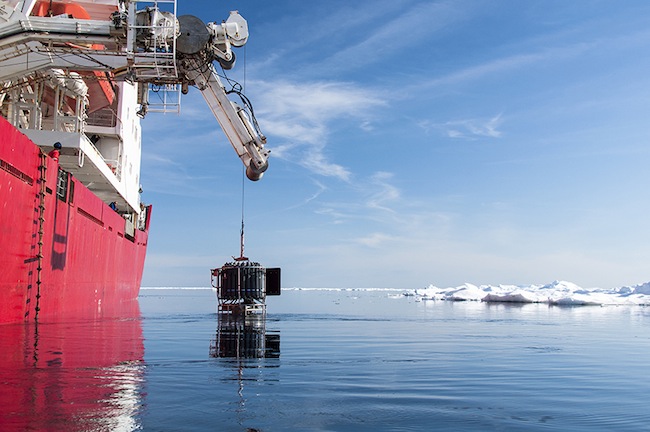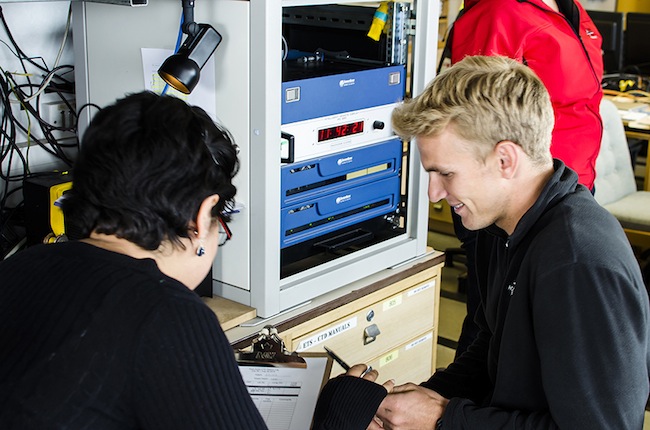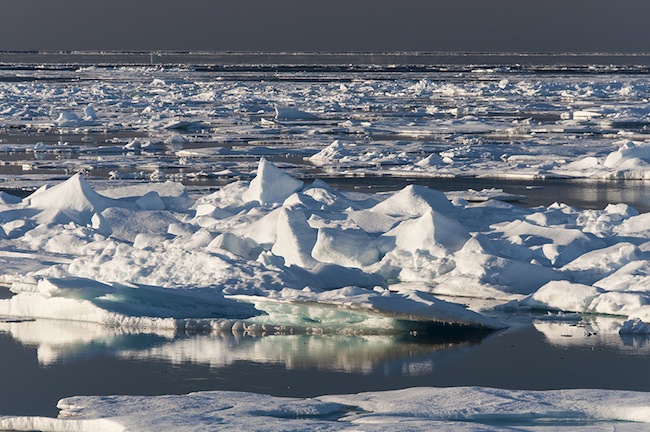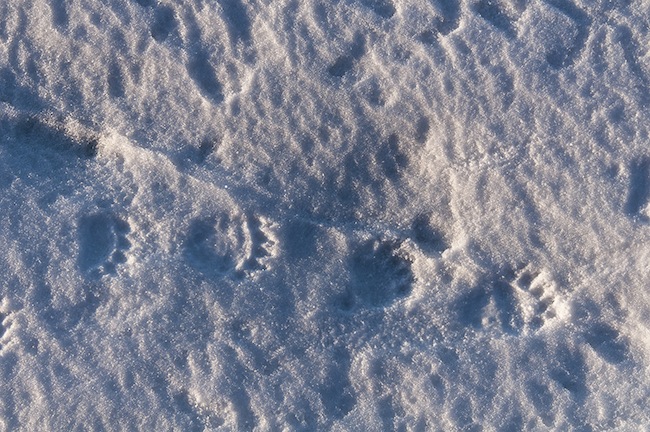20th August 2012
To those of us who’ve fallen so thoroughly under the Arctic’s bedazzling spell, the high-latitude light, the mountains and ice, the animals and the cold ocean glow in memory long after we’ve returned to the temperate zones and bored our friends with over-caffeinated descriptions and sea stories. But even the runniest romantics like me recognize—and some of us have seen—the Arctic’s other personality, violent and remorseless, a killer lurking just out there on the far side of the fog bank. That’s okay when you’re aboard a sound ship; the extremes contribute depth and render even sweeter the rare summer sights we’ve seen so far.
When I was a young man, I thought that the aesthetic response to nature was pure and deep and the scientific approach to it was reductively literal, chilly. Time, experience, and a little knowledge erase youthful certainty; one sees that neither perspective threatens the other, and both together enhance the whole. Nowhere has that been clearer than here, doing science in the sea ice (well, maybe the Greenland, maybe Jan Mayan). There was not a cloud in the light blue sky, or hardly a knot of wind to riffle the surface. Sun glinted on the sea ice crystals. The submerged parts of the thicker multi-year ice floes and the melt-water pools on their tops took on a turquoise hue. The countless floes undulated in a gentle swell. Though still 50 miles off, the Greenland coast was clearly visible, but the crystalline Arctic atmosphere was playing its tricks, dazzling our perception, stretching, vertically elongating the mountains and the bergs such that they appeared suspended, shimmering improbably in mid-air. This is the famous Fata Morgana that comes up so often in exploration literature; you read stories by terrestrial travelers who spot a polar bear in the distance, and, approaching, guns leveled, they find an Arctic hare.
The levitating bergs, the white sea ice in their broken-glass shapes and sizes, the trickster mountains on the coast, the perfect beauty—the aesthetic part is deeply enhanced by the sense of purpose, that is, to understand the environment. And to exaggerate only slightly, the condition of the Arctic environment proceeds from the condition of the ocean. To understand the ocean, scientists must first measure it. And that brings us to one of most fundamental oceanographic tools, the CTD.
“Deck, bridge,” radioed Chief Mate Robert.
“Bridge, deck,” George the bosun replied from the maindeck, four flights below. “Good morning, Chief.”
“Good morning, George. We’re ten minutes from station.”
“Ten minutes, aye. Thank you, Chief.”
'That’s pretty much all the data you need to understand what water goes where and how fast.'
|
It’s sometimes called the “rosette,” the “package,” or simply the CTD. That stands for Conductivity-Temperature-Depth. Seawater salt conducts electricity. By measuring the conductivity and applying an algorithm or two, you can determine salinity. Temperature and depth are pretty self-explanatory. Sensors mounted beneath those gray sampling bottles (see photos) measure all three and transmit the data back up the specialized oceanographic wire to computers in the control room. If you glean temperature, salinity, and depth, you can identify the water’s fingerprint and it’s position in the water column in real time. If you mount an ADCP or two on the package, you can determine current velocity and direction. That’s pretty much all the data you need to understand what water goes where and how fast.
So here’s the process that’s been going down since the mooring guys left the ship in Iceland. Bob has chosen propitious points in the East Greenland Current, some before he ever left his Woods Hole office, to run a series of picket-fence CTD casts across the current, 257 of them at this writing, the shallowest in 40 meters, the deepest 2,600 meters. The big advantage of the CTD is that it’s portable. If Bob sees some current activity that interests or surprises him, he can add casts to a particular line of them or lay a whole new line in a different area. Bob and Kjetil spend hours shoulder to shoulder parsing the graphic, color representations of the T/S profiles delivered to Bob’s computer to decide what they’re seeing and what, accordingly, to do next.
The disadvantage is that one cast produces a single point measurement of the current at one particular time, while ocean currents vary infinitely in space and time. A line of CTD casts—particularly with Bob’s trademark tight-resolution picture—addresses but doesn’t entirely solve the problem, because CTDs can’t accommodate temporal variability. I suppose that in an ideal world he’d plant a string of moorings at various spots across the EGC, measuring temperature, salinity, and velocity over a full year, but moorings are crushingly expensive in hardware and ship time. Besides, Bob, Kjetil, Laura, Steingrimur and Hedinn have adequately covered with moorings the Denmark Strait Overflow, which is the main area of concern. But combine those two most basic of oceanographic tools, and you gain a very powerful insight into the activity within the strait itself as well as the currents (EGC and North Icelandic Jet) that feed the overflow.
“Bridge, deck.”
“Deck, bridge, go ahead, George."
“Permission to launch the CTD.”
Carolina Nobre and Eric Brugler discuss the CTD data |
JCR was parked in a patch of open water amid the floes. Bosun George, at the winch controls, lowered the CTD into the water. Dana and Eric, the on-duty CTD watch (there are three two-person watches, and Carolina is in overall charge of CTD ops), who actually direct the cast, waited at the computer console, while some of us searched for bears. The package goes down at 60 meters a minute until within about 100 meters from the bottom where the down-looking altimeter mounted on the bottom of the package kicks in, and the winch driver slows descent to 30 m/s before stopping five meters from the bottom. The worst thing that can happen is to crash the package on the bottom; we’ve seen it happen on other cruises. On this one, the operators have been perfect.
The current isn’t of concern only to scientists. Its “set and drift” matters to mariners. The south-setting current was carrying ice down on the ship at the pace of a brisk walk, and a big, ragged floe was bearing down on the starboard side—and on the vulnerable CTD wire. The Captain watched it for a while before he took evasive measures. He pivoted his ship around the wire, while keeping it perfectly vertical. He then met the floe with his port bow and used it to brush the ice aside as he pivoted the ship back to her original position. It was a beautiful thing to watch.
* * *
That line was complete by mid-afternoon, and we began a 100-mile steam to the next one up at 75° N. Most everyone stayed up far too late, laughing, reveling in the buttery evening light on the ice (the sun sets briefly at about 2300), still watching for bears. The polar bear, as we’ve heard time again, is the “icon of the Arctic,” but the symbolism is too compelling to ignore for that. This beautiful animal, stuffed-toy cute, someone said, afraid of nothing, can, like the Arctic itself, kill you in an instant, but it can’t survive unchanged in the face of the warming ravishing the Arctic. The melting Siberian permafrost is belching yet-unknown quantities of methane into the atmosphere, the Greenland glaciers are visibly retreating—you don’t need to be scientist to see it—and the sea ice is vanishing. The bears are probably too smart, too adaptive to go extinct without a fight. Perhaps they’ll turn terrestrial, but for them, like the Arctic, itself, nothing will be the same. Tourists on the fantail, we didn’t want to talk about that sad side of the story to spoil the mood. Alas, we must.
- Dallas
